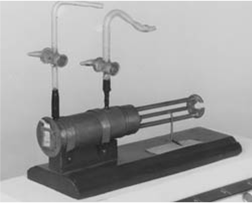|
The thin metallic foils applied by Hans Geiger and Ernest Marsden in 1909 for observation of the alpha particles behaviour and the tube filled with nitrogen gas used in studies on alpha particles collisions with light atoms carried out by E. Rutherford and his team in 1919 can be considered as first solid phase and gaseous targets used in nuclear studies. In 1909 H. Geiger and E. Marsden reported results [1] of their observation of behaviour of alpha particles emitted by radium emanation [formerly – radon (222Rn)], radium A [218Po] and radium C [214Bi] when passing through various metal foils. For this experiment they used foils of various elements starting from aluminium (atomic weight 27) up to lead (atomic weight 207) observing that the number of the deflected particles increases with increase of atomic weight of the foil material. How the targets used in these measurements were described? This behaviour of alpha particles was explained by E. Rutherford in 1911 with a new atomic model in which the entire positive charge of the atom is concentrated in a very small central part and electrons occupy the space surrounding this part [2]. This central part was named “nucleus” by John Nicholson in a paper published late 1911 [3]. The idea of this tiny positively charged central part of atom was not fully original as it had been presented by Hantaro Nagaoka [4] already in 1904. After studies of alpha particles behaviour with heavier elements a natural question how they will interact with light atoms came up. This observation was performed using nitrogen-filled tube and alpha particles originating from 214Pb placed inside the tube. It led to the discovery of nuclear transmutation originally described by E. Rutherford as ‘Anomalous Effect in Nitrogen’ [5]. The later works performed by P. M. S. Blackett [6] confirmed creation of hydrogen in this collision and showed that alpha particles are not bounced by the nitrogen but absorbed.
Fig. 1. The gaseous target used by team of Lord Rutherford for studies of alpha collisions with light atoms. Protons produced in the reaction were detected by scintillator placed at the end of tube seen on the left side of the photo. In these early experiments the projectiles originated from natural radioisotopes. The energy of the projectiles emitted in the radioactive decays is however not sufficient to overcome the Coulomb barrier of heavier nuclei, which is a necessary condition of a nuclear reaction. Further studies with heavier nuclei become possible with the development of devices able to boost the projectiles energy to higher level. The higher energy of the bombarding projectiles can be achieved in devices accelerating the charged particles and directing them towards the target when attaining the appropriate energy. The development of accelerators able to deliver high energy projectiles increased the requirements for the targets quality. This triggered the development of techniques of target preparation to satisfy demand for targets with more sophisticated properties, robust under bombardment with high energy projectiles. Initially the targets were prepared by the experimenters themselves but with time the target design and preparation become more complex and required wide ranging skills. To enhance the exchange of the ideas and knowledge on techniques used for target preparation, a seminar gathering the target makers was organised in 1963 at Geel, Belgium, most probably the first of such kind. Further meetings were organised at irregular intervals, sometimes with only regional participants, until 1975, when the International Nuclear Target Development Society (INTDS) was incorporated. The INTDS started organising regular world meetings, initially annual and later biennial, continuing to date [www.intds.org>conferences]. |
[1] Henry Geiger and Ernest Marsden, [2] Ernest Rutherford, [3] John W. Nicholson, [4] Hantaro Nagaoka, [5] Collisions of alpha Particles with Light Atoms. IV. An Anomalous Effect in Nitrogen, [6] Patrick Maynard Stuart Blackett, |

